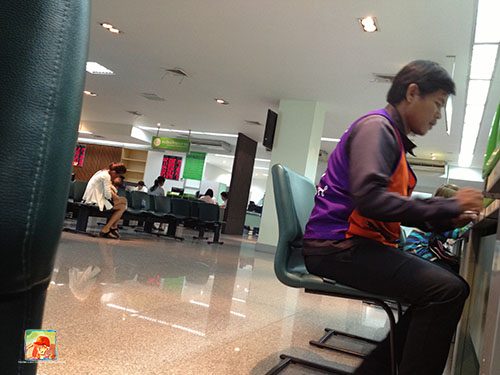
Sep 9, 2013 |

Not too many people in the office at the time…
Is a pulse and a measly 20THB. As you all may know by now the wifey and I opened up a small cafe. We got our lease/contract from our landlord so we made our merry way to the local Thai government business registry office. It’s a big office building but totally nondescript because it’s down a soi. Taxi drivers seem to not have a problem locating it because it’s such a well known government office.
Anyways getting our cafe registered took less than 10 minutes. And it only cost 20THB, less than a $1US. Well if you count the photo copies I had to make of the contract and my wife’s Thai ID card the cost is actually a little over $1US.
I remember about 5 years ago it cost me $200US just to register and incorporate a business. And I had to wait about a week.
Not that I was rushing at the time.
But it’s a bit amazing to me on how fast we could open up shop. Hell, we didn’t even have our legal papers the day we opened up until now. Back in the good ol’ USA that just wouldn’t fly with the authorities including Mr. Taxman.
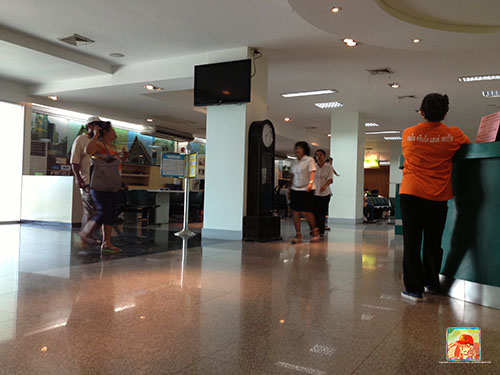
Speaking of taxes, since we’re a small business we don’t even have to pay any taxes. I’m not knocking the US. I love my country. But sometimes the rules and regulations for the little guys can be overwhelming.
I remember a good buddy of mine who opened a bakery forgot to renew his business registration. The penalty for that tiny mistake was a little over a $1000US. That’s just plain nuts. And business was a little slow at the time for him so it was a big hefty chunk of change to hand over.
So far business for us is picking up slowly. We have our up and down days.
Part of my big challenge here in Bangkok is the bakery. I’m experimenting on a lot of different recipes and learning along the way that Thai people like their desserts to be soft.
What does that mean? Well, they don’t like chewy foods especially chewy desserts. So I’m looking into recipes for soft cakes and breads. Maybe they’ll like puddings too?
I’ll put up a pic of my shop after I pick up the painting we paid a painter to paint. I also want to buy some paper mach cats. But it cost about $35US for a big one and the smaller ones cost about $10US each. They’ll look good in my shop but man paying that much for paper art is not easy.
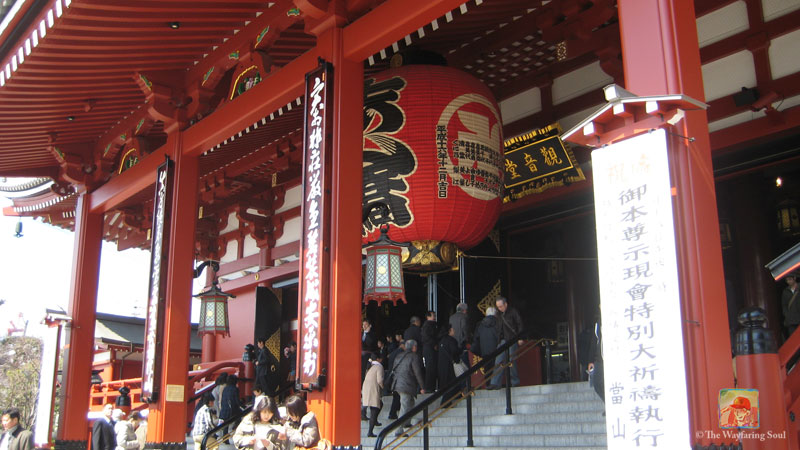
Jun 13, 2013 |
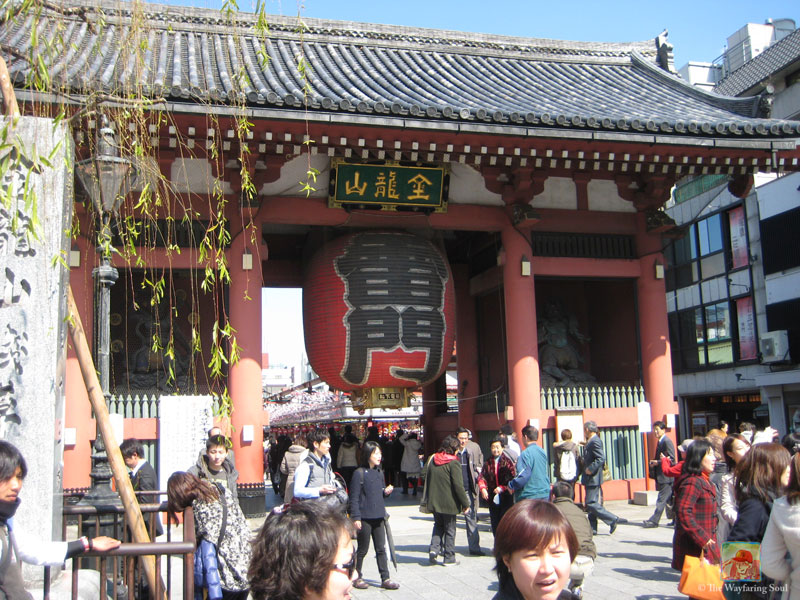
Kaminarimon Gate at Asakusa
A big reason why I love traveling to Japan is because they are one of the few countries in Asia that keep a priority on maintaining their culture and traditions. The Asakusa district is one perfect example and I went there last year around March. The temperature was still a bit chilly that time but it was still an awesome day!
Normally I stay at the Shinjuku district but if you’re looking for affordable hotels in Asakusa also it’s not a bad choice. There are plenty of train stations in the area and no shortage of good restaurants.
The main attraction in Asakusa is the Sensoji Temple. Followed by the street stalls and shops called Nakamise that line the way up to the temple. And surrounding Asakusa are many traditional styled shops selling food, snacks and of course a whole lot of souvenirs. Pricey souvenirs too especially the hand made items. I didn’t buy any thing because I’m not a real big shopper. I typically buy souvenirs at Narita airports duty free shops to take back as gifts. This way there’s no need to lug extra stuff to the airport.
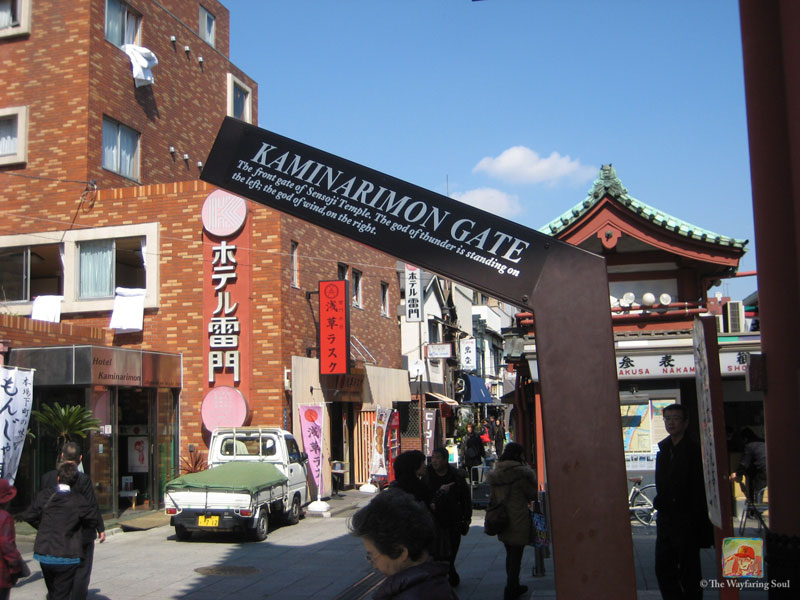
So I’m not a shopper. But I am an eater. There’s certainly no shortage of Japanese styled sweets and snacks to enjoy on a beautiful day. The temperature was in the low 70’s and I remember that the days before was rainy with light snow throughout the day. But that day in Asakusa was absolutely marvelous.
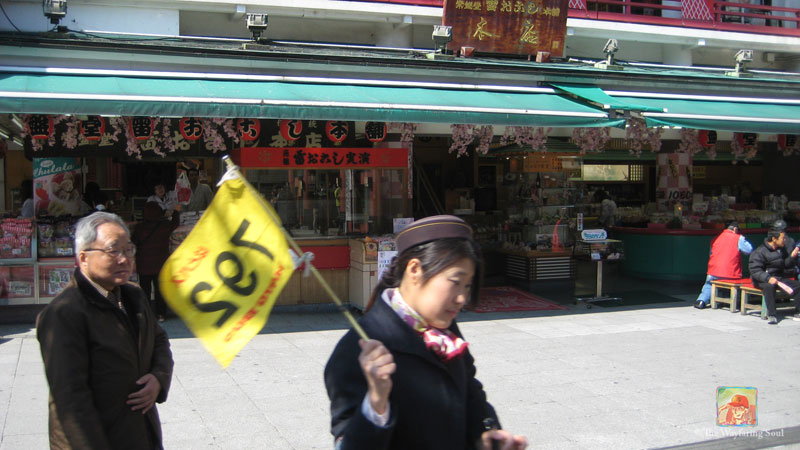
Though there were many foreign visitors in the area it’s a very special temple for the Japanese. Matter of fact there were more locals than tourists. Because Sensoji is a really popular Buddhist temple. Shintoism is the main national religion of Japan. Buddhism is the second most popular belief in the country. I didn’t know that little fact until I visited Asakusa. See, it’s still possible to learn something new everyday!
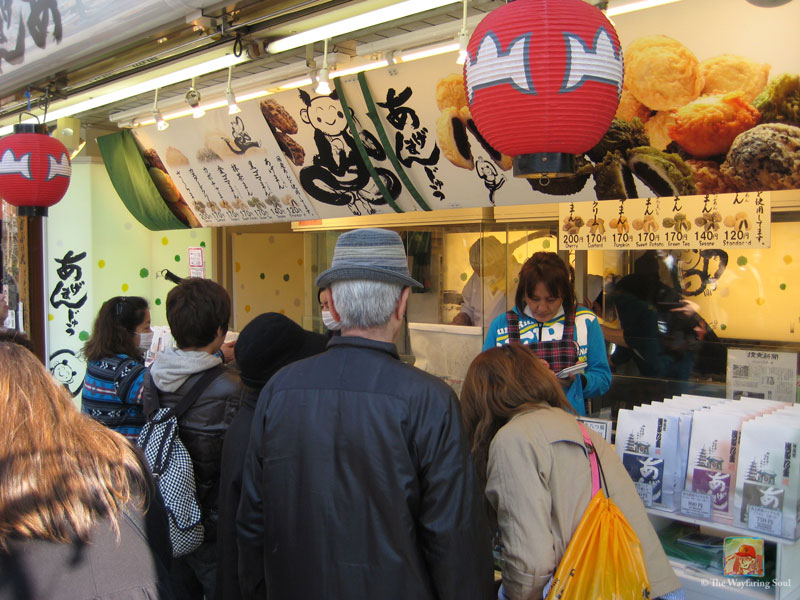
Agemanju shop…
So there’s a lot of sweets that I easily recognized from other Asian cultures. Like sweet dough with sweeter bean paste. I was hunkering for something unique. Something Japanese. I came across this little shop and heard the gentle murmurings of fryers going on. Anything that’s fried can’t be bad!
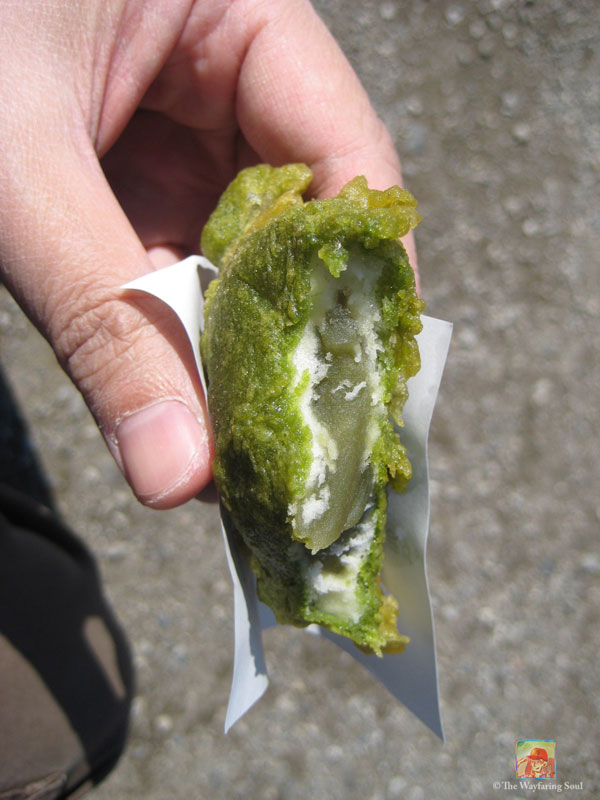
Just $1.50USD for this yummy fried morsel, surprisingly it’s not so greasy…
Plus the place had a line of locals waiting. Which is an even better sign. It’s a shop selling Agemanju with a good variety of flavors and fillings. It’s basically a fried battered soft cake filled with your choice of fillings. Though there were a lot unique flavors, I just went ahead and bought myself a green tea agemanju with green tea infused bean paste. I found a seat nearby and just sat my ass down and scarfed every morsel with the warming sun on my back.

The steps to the entrance of Sensoji Temple…
I really can’t stress how nice the day really was. There were lot’s of people all around enjoying the day too. And they come to Sensoji Temple to make prayers in hopes that their wishes come true. And though the temple is mainly Buddhist there is a touch of Shintoism which involves cleansing. So you’ll find an area where people can cleanse their hands.
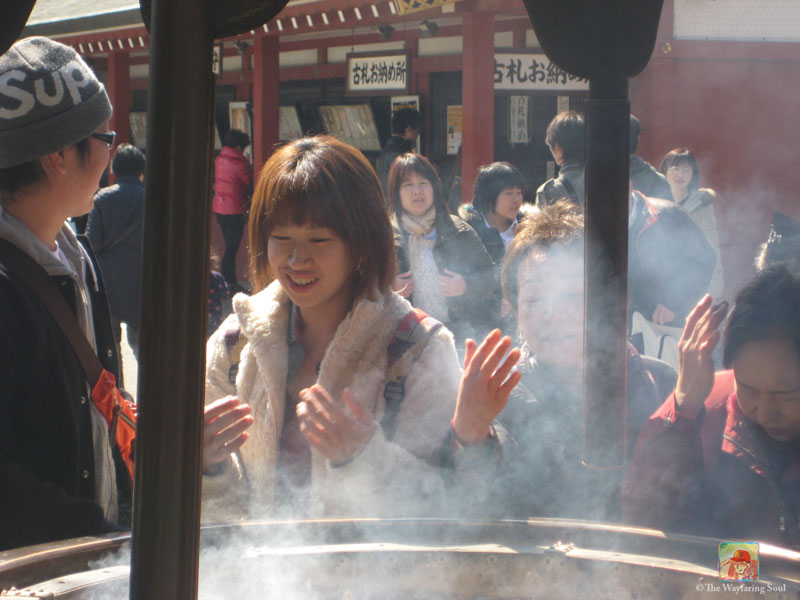
Cleansing with incense…
And you’ll find an area right in front of the temple where they can “wash” themselves with incense. It’s a deeply religious site with many devote followers and you get this wonderful sense of peace and joy.
After wandering around the temple area I made my way back down Nakamise to take more photos. It was late afternoon by then and there were still a lot of people streaming in. Asakusa and Sensoji Temple is definitely a must not miss visit when you’re in Tokyo!
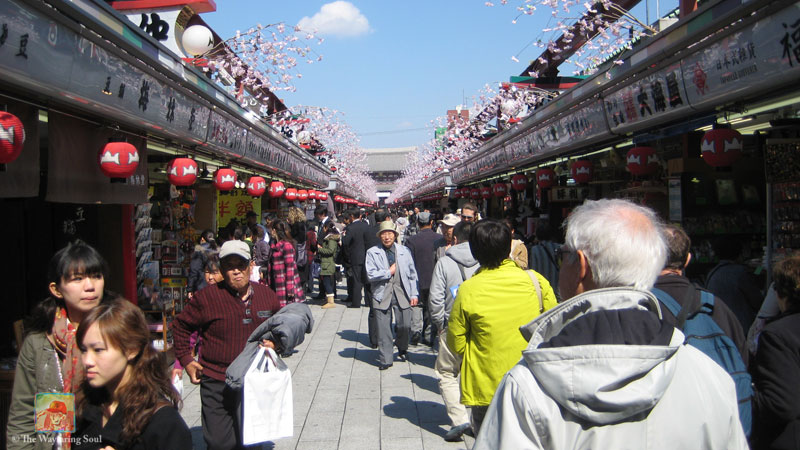
This shopping street called Nakamise leads all the way up to the entrance of Sensoji Temple…
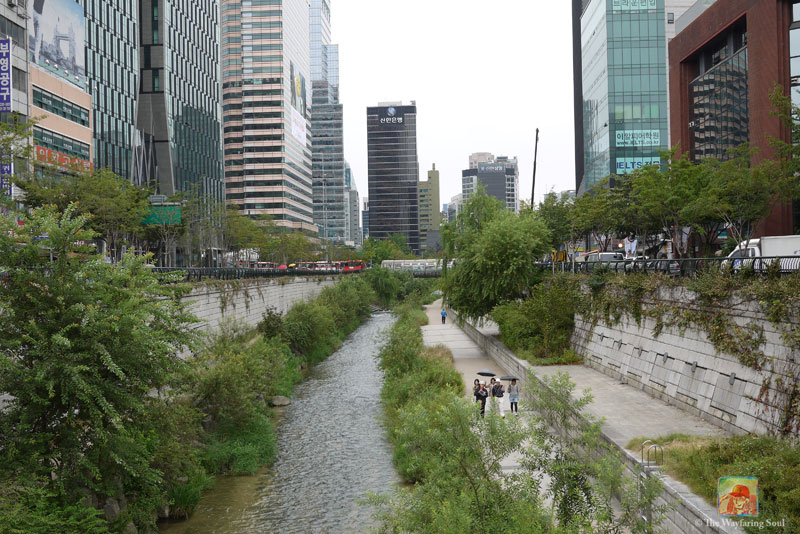
May 16, 2013 |

It was a gloomy day while I was there but still a nice place…
From my experiences, there are not a lot of Asian countries that take care of their environment. I know that has a lot to do with social-economic situations of every Asian country. A rich nation though doesn’t guarantee a green environment however. Case in point China.
South Korea’s got cash too. And they’re doing right by making their cities as clean, green and friendly.
Seoul’s Cheonggyecheon Stream is a prime example. It’s a long river that cuts through most parts of central Seoul, connected the Han River. Before 2005 Cheonggyecheon Stream was covered up with a highway overpass and after that for around 50 years the stream ran dry.
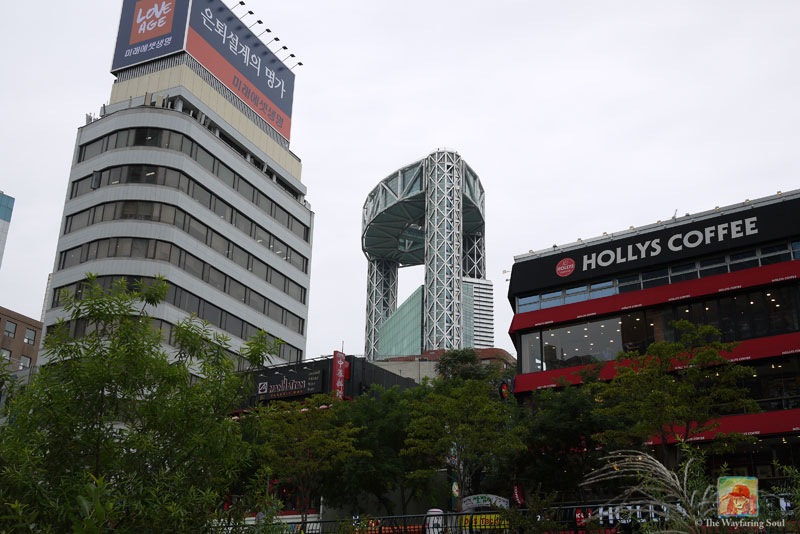
Lots of shops and offices on both sides of the stream…
So the government pumped $900 million bucks to bring the stream back to life and it was a colossal urban renewal project. Water had to be pumped back into the stream and since the highway was removed traffic had to be directed elsewhere. With that huge dollar amount you can bet there were a lot of complaints. So was it worth it?
From this traveler’s opinion. Yes. I have no clue if there are anymore complaints from the locals but I am sure that millions of South Koreans and tourists from around the world are enjoying Cheonggyecheon Stream. It’s a great place to chill out. If I had a job in Seoul near the stream I would certainly eat lunch there every afternoon with my shoes off and feet dangling in the cool, crisp clean water. It’s a great area to jog around too and I know South Koreans love to keep fit. Plus festivals are held by the stream which many Koreans go to experience and enjoy with families.
And the cool running water cutting across the city helps keep the temperature down when the weather gets hot. It’s environmental friendly and pleasing to the eye.
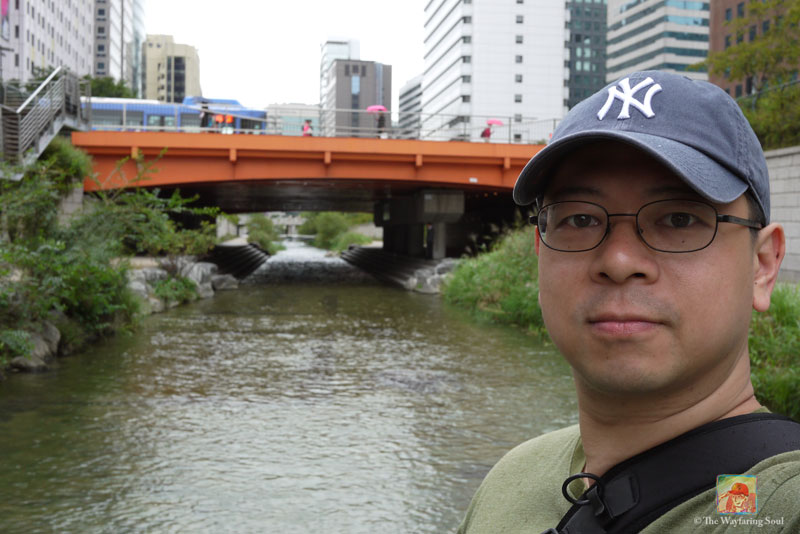
Geez I’ve got some chubby cheeks…
Cheonggyecheon Stream is 6km long, about 4 miles which is long. I’ve never tried walking the entire extent but I will be in Seoul on in July for another 13 hour layover. Now I’m deciding if I should try to walk the entire length of the stream or try and visit 5 major palaces in Seoul instead. So much to do in Seoul. So little time. God I love this city! I mean even the name of the city sounds so cool!
But since July is supposedly a hot and rainy month I’m just going to have to play it by ear. Until then, I can’t wait. I do love Seoul and can’t say it enough.
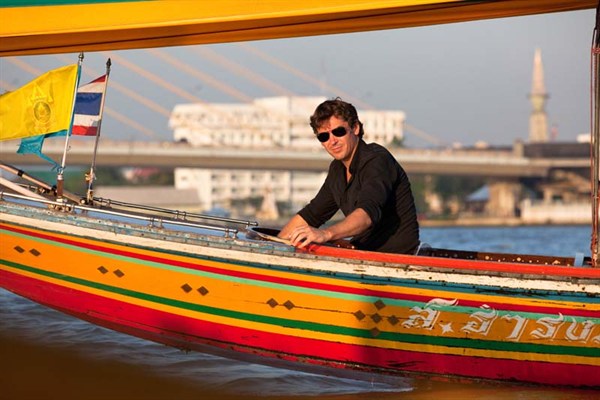
May 14, 2013 |
Last night I watched a television show called Scam City on the Science Channel. It’s a show revealing scams perpetrated by con artists in major cities around the world. The lasts few weeks I watched episodes on Rio De Janeiro, Buenos Aires, Prague and last night the episode on Bangkok.
I was super curious and excited to watch the episode on Bangkok because sure I know about the tourists scams. I’ve never fallen for one because you hear so many stories already about getting ripped off by gem stores when they advertise a “last day 30% discount on high quality gems”. Or sex show (never been to one either. Really, I’m not lying) touts promising bottles of beer for 100THB ($3USD) but only find out when the bill arrives a bottle of beer cost 10x more. And if you don’t pay the bar will threaten you with physical harm.
Scam City’s host, Conor Woodman places himself right into the scams while capturing the whole event on hidden cameras. And he’ll have a buddy follow along with another camera filming everything with a DSLR. So it was interesting to see what actually happens in gem shops and sex shows. It’s a whole lot different than reading about it.
Like the gem scam. These scam artists mainly hang around the tourist attractions, like the Grand Palace, National Museum and Wat Pho in the old quarters. They also hang around the commercial districts of Bangkok too, like near the Four Headed Buddha in Chidlom and Silom by Lumphini Park.
The modus operandi is always the same. Thai con artists are neatly dressed. And they can speak conversational English and tell you they are professionals, like accountants, doctors, lawyers, etc. These are ways to lull tourists into a false sense of security. Then they’ll proceed to “fill you in” on special sales of precious gems with a 1 day sale that only occurs every 7 years. They’ll start piling on more BS by telling you can make good money by reselling them back home.
And tourists do fall for this. Matter of fact on the Bangkok Scam City episode, Conor had a video chat with a New Yorker who bought some gems in Bangkok following the suggestion of a con artist. When he took the gems back to the Diamond District in NYC the dealers were telling him the stones were not worth as much as he paid. Even though with all the information out there warning tourists of gem scams, people are still falling for it. Unbelievable.
Anyways, here is my 1 BIG TIP to AVOID GETTING SCAMMED IN BANGKOK. If anyone approaches you in the city, do not talk to them. This is especially true when they can speak perfect English. It’s the same what mom taught you as a kid. Don’t talk to strangers.
Yeah, I know, that advice sounds so anti-social. Isn’t one of the facets of the joy in traveling is to meet new people? Sure, I guess. But we’re not in a story book world like Eat, Pray, Love. It’s a sad fact that if you don’t want to have a scam ruin your vacation in Bangkok then don’t speak to strangers who approach you.
I’ve been approached too by by con artists hanging outside of the Grand Palace. And they’ll flat out lie and tell me it’s a Buddha holiday so the Grand Palace is closed, even when the entrance is just 30 yards away and you see dozens of tourists streaming in and out. I just ignore them. And you should too.
Okay, I don’t want to scare off anyone from visiting Bangkok. Hell, even innocent Thais get scammed, probably a lot more than tourists. Really, I’m not kidding. I hear so many elaborate schemes concocted by Thai con artists that it’s hard to believe. Check out my post on one instance where I got scammed. That happened far from any tourist centric areas.
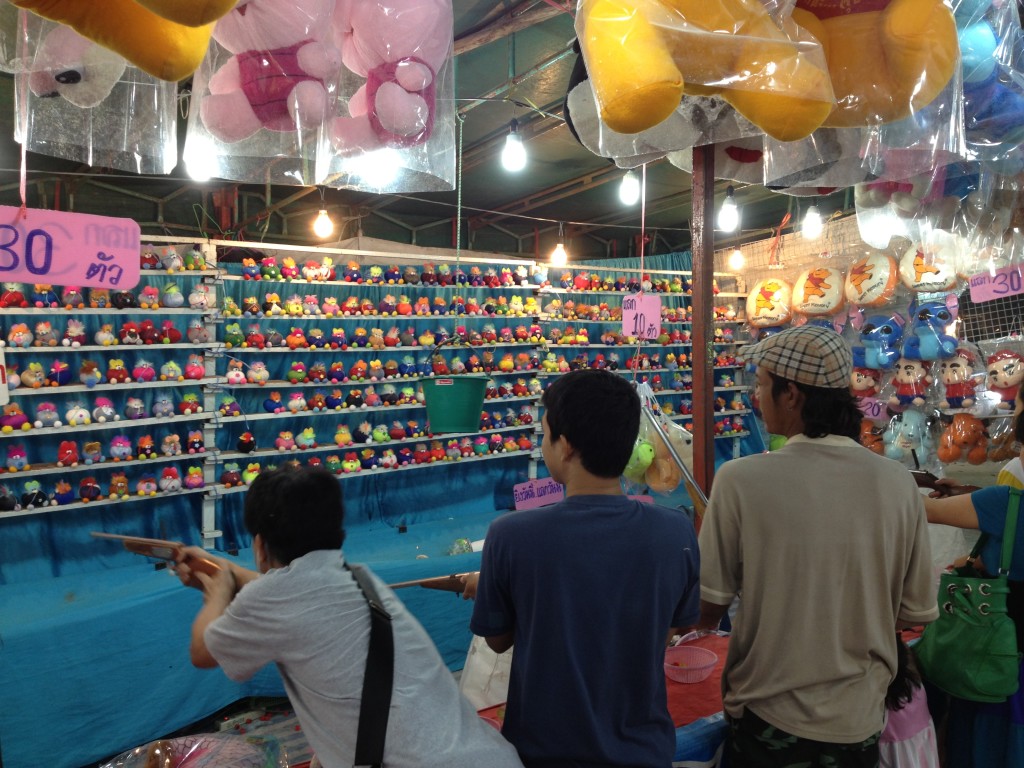
Fly by night carnivals scam local Thais every night…
And from watching past episodes of Scam City, Bangkok is not that bad. Not that I’m making light of a bad situation. In Buenos Aires, Conor discovered that tons of counterfeit pesos are floating around. And most bogus bills were passed off to tourists from taxi drivers. Even some shop keepers were handing bogus bills and some were short changing tourists. I did some more research and found instances where ATMs in Buenos Aires had counterfeit cash too.
In Rio pickpockets are quite brazen during festivals though this type of crime happens in every tourists hot spot the Brazilians take it to a whole different level. In Prague, depending on which taxi company you choose you can be paying 5 times the normal rate. And if you don’t pay the driver might have a weapon to change your mind. Also in Prague currency exchangers charged fees but you wouldn’t know unless you can read Czech.
Serious crimes against tourists does occur in Thailand especially in the big cities, just like it does in most major cities in the world. Though not as frequently but everyone should be cautious no matter where they go. But from watching episodes of Scam City, Bangkok is quite tame. So to increase your chances to avoid getting scammed, do what your mother taught you long ago and don’t talk to strangers who approach you.
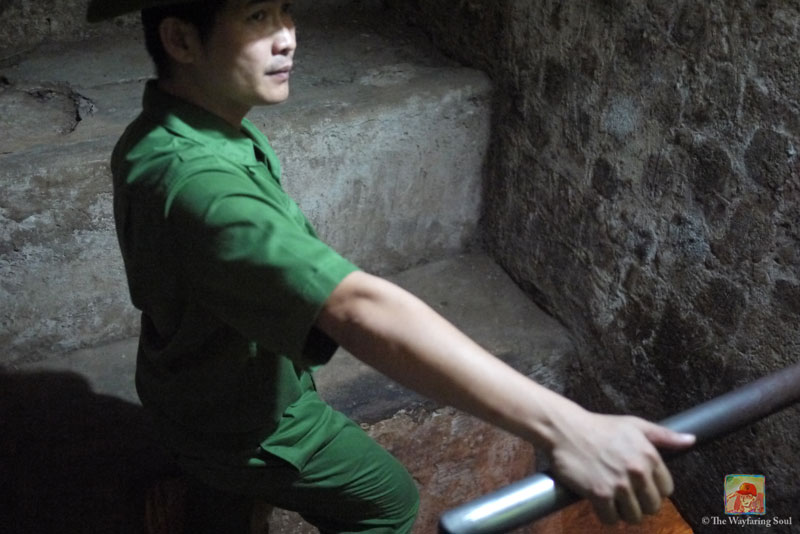
May 11, 2013 |
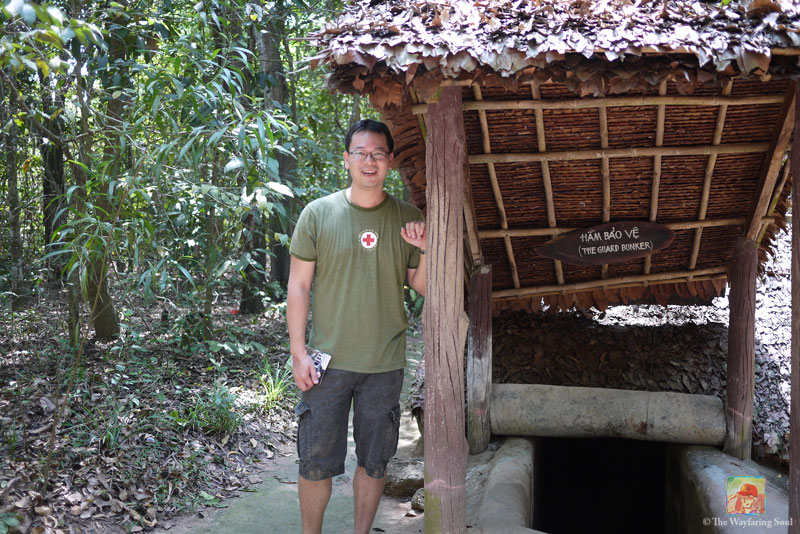
Smiling cause I was glad I was out of the tunnel…
I’ve been to Vietnam a few times. Mostly traveling on my own on to do a Visa run. Last year though I made a trip over to Ho Chi Minh City with a few friends from Bangkok. And one of them suggested going on a half day tour of Cu Chi Tunnel. I don’t normally take tours but this was the type of place that looked really interesting on the brochure. I was born a year after the Vietnam War ended when the city of Saigon was renamed Ho Chi Minh. And since I watched a lot of Vietnam War movies I though it would be interesting to see a part of the war’s history.
Cu Chi Tunnel in a way was a North Vietnamese Army (NVA) stronghold against the US military and their allies. The NVA lived, hid , and planned in the tunnels. It’s possibly one of the main reasons why they could outlast the Americans in the Vietnam War. And surviving in the tunnels was not a walk in the park for the NVA. So it would be interesting to learn what they had to go through.
Anyways the price for a half day tour to Cu Chi Tunnel was really reasonable. As I recall it was around $15USD which the hotel arranged to have a van with a driver and tour guide pick us up at the hotel. We stayed at the T. Espoir Saigon Hotel (formerly Truong Hai Hotel) by the way, which is near the popular Ben Thanh Market in central HCMC.
After getting picked up by the van on schedule the driver made several stops at different hotels to pick up more tourists. After that the drive to Cu Chi Tunnel was on the way. But a stop was made to some sort of lacquer factory where artworks were hand made by locals. Yes, it’s the type of joint where the tour guide and most likely the driver makes a commission. But who cares, it’s not expensive and supposedly the proceeds from sales goes to training locals and giving them jobs. I bought two pieces of art and it only cost about $20USD.
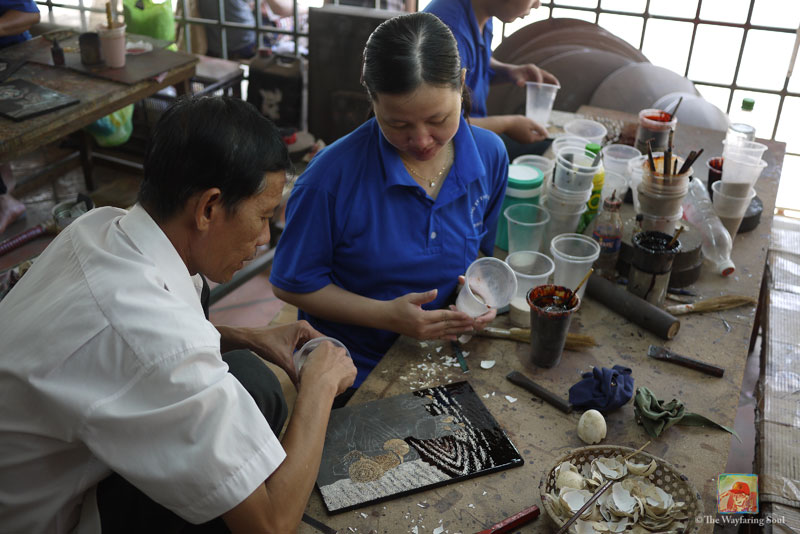
On the job training at a handcraft workshop…
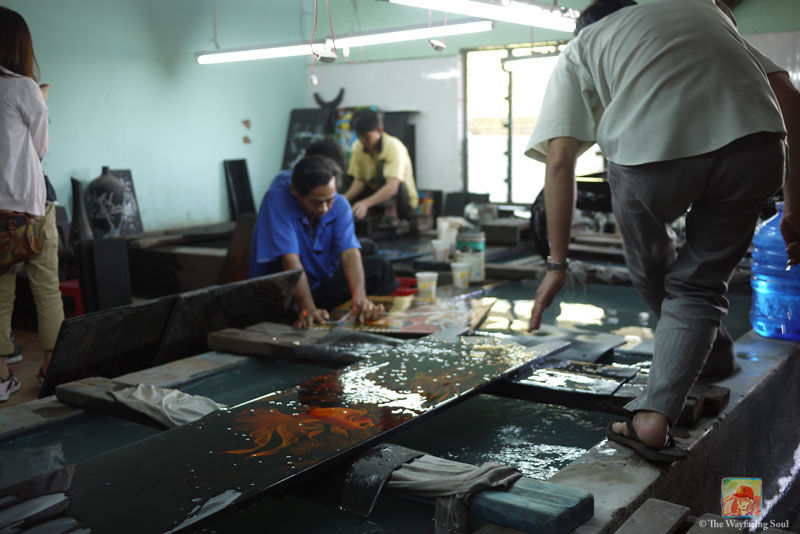
This is where they add a layer of lacquer to give the pieces that shiny coat…
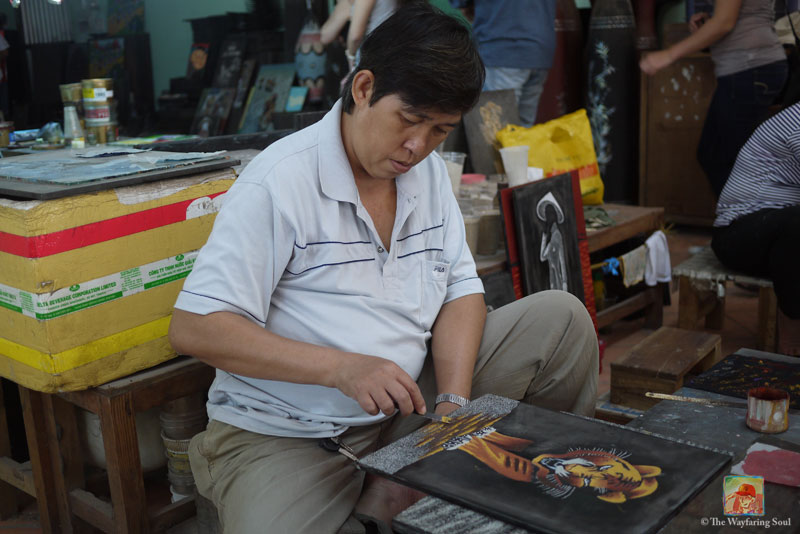
All handmade with duck eggshells…
After spending about 45 minutes inside the factory, every one was back in the van and on off to our real destination, the Cu Chi Tunnel.
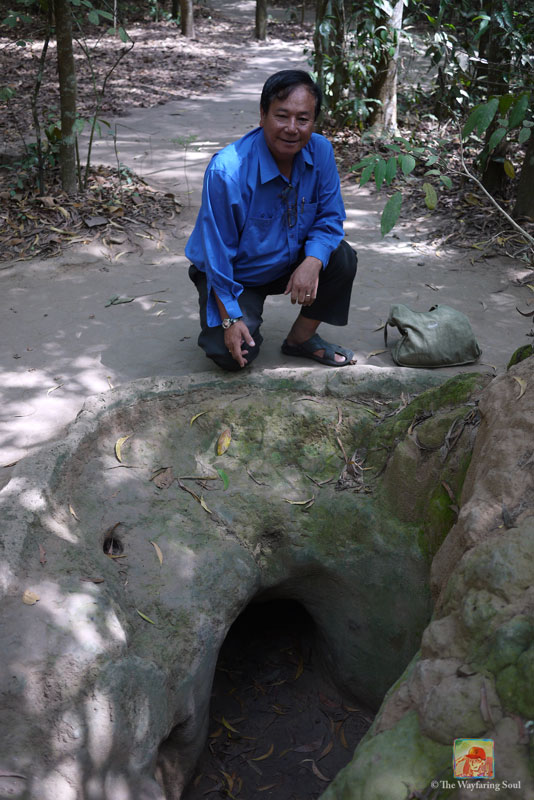
Our tour guide giving us a preview of a tunnel…

He’s the actual guide that takes tourists into a tunnel…
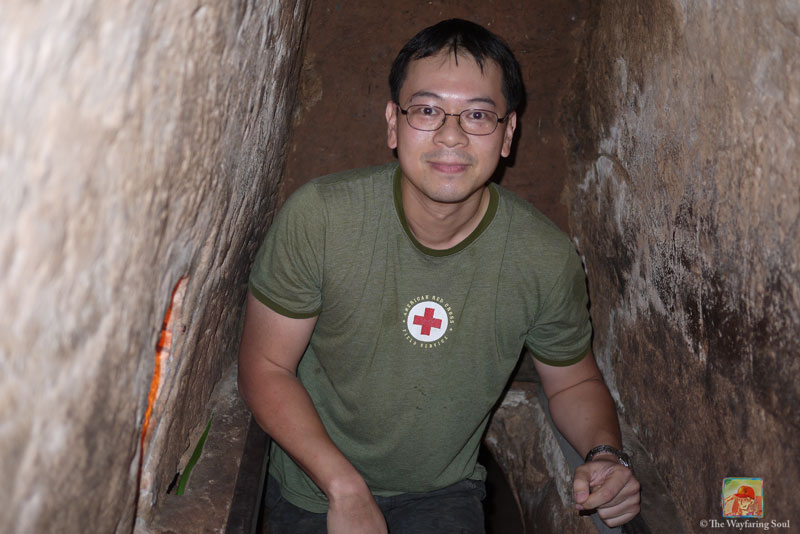
I’m inside the tunnel trying to be cool…
So before entering the tunnel our tour guide would give everyone a short history of how the NVA survived in the tunnels even though conditions were bad. They had to deal with all kinds of diseases inside the tunnels as well as fight battles. What he didn’t tell everyone was that we were actually going inside of one. Granted the tunnel system we entered was fixed up with some lighting and fumigated to get rid of all the insects and rats. What he didn’t mention is that the tunnel is small and you’d have to either crawl or crab walk through. It’s probably fine for people with small frames and around 5′ and a half feet. But if you’re taller with a bigger frame like me you’re a bit shit out of luck. The NVA were smaller in stature and suited their needs.
Luckily I was directly behind the park ranger who led our whole tour group through a sissified tunnel system. I followed him as close as I could. Because he was moving fast. At least he was nice enough to stop ever so often and take a few pics for me. Lucky I didn’t crack my camera because I was hand holding it the entire time. I have to admit, I was getting scared and looking forward to getting out. I could hear my friends behind asking where was I. Somehow they fell behind along with the rest of the group.
Anyways the park ranger kept going and I believe we crawled through 50 yards until and exit came up. The width of the tunnel was about 3 feet across and 4 feet high. Some points of the tunnel was a few inches smaller. Even though it’s only a few inches, in a space so small already, it was a big difference. Once I was back out the park ranger went back in to get everyone else out. And I was sweating like a pig by then. I’ll tell you, this kind of tour is not for those who are claustrophobic or have a physical disability. The rest of the group along with my friends came back out in about 3 minutes. I had to admit, I was a bit worried for my friends.
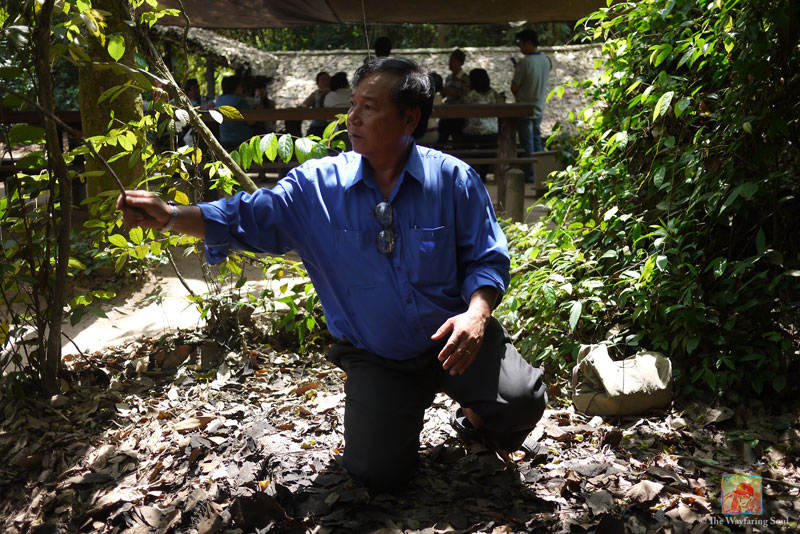
We were getting a lesson on how the NVA concealed themselves…
So what else was there besides crawling through a tunnel and getting the wits scared out of you? There’s a shooting range where you can fire off a bunch of bullets on Vietnam war era weapons and you’d have to pay for that separately. I didn’t try it out though but it was kind of unnerving to hear the loud sounds of rounds going off just a few yards away.
Visiting Cu Chi tunnel was a nice little side trip. And I got a chance to glimpse the area just outside of Ho Chi Minh City. One thing that might irk a lot of travelers who join tours is that often most tour companies include stops at a local souvenir shop. Yes, that’s where the tour guide or driver makes some extra cash when someone buys something because the places they bring you to have expensive souvenirs.
I saw quite a few people in our tour group have a “WTF” look on their faces. Sure, I understand, nobody paid to go to a souvenir shop. But that’s just the ways things are with Asian tour companies. I’ve even had tour guides sell stuff on a tour bus while in Japan. Which is why I don’t usually go on tours. At least you don’t have to buy anything. I say just go with the flow. After a short 30 minute stay the guide started dropping off everyone to their hotels.
I had a good time at Cu Chi tunnel. It was a good learning experience about a controversial times in history that I’ve seen so much on television and movies. So I’m glad I went to check it out.
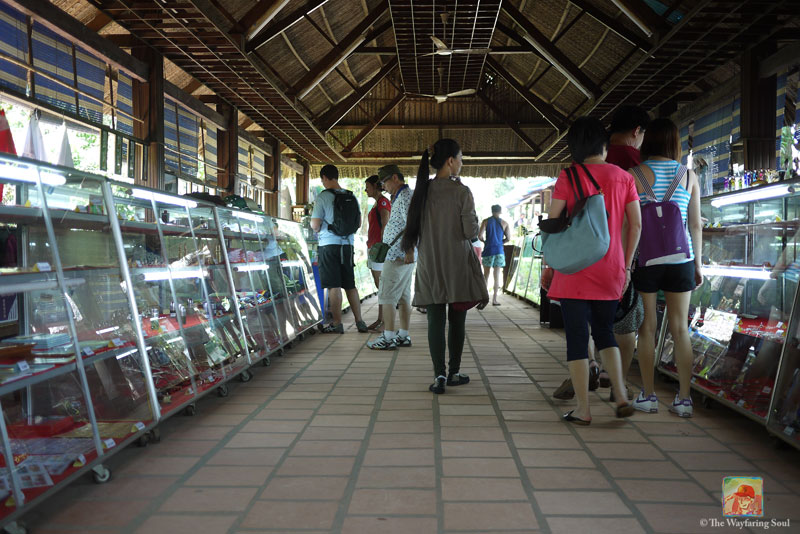
What’s at the end of every tour attraction? A souvenir shop of course!
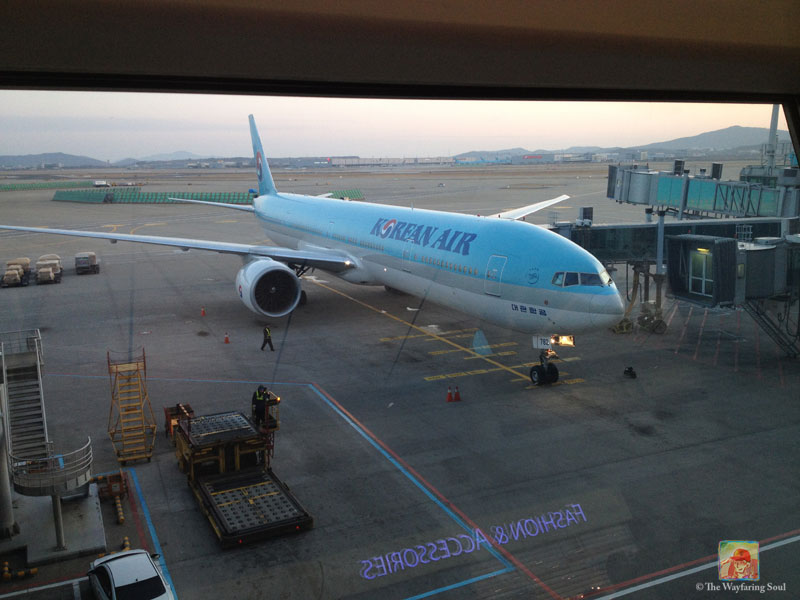
May 6, 2013 |
For the past 3 return trips I’ve made to Thailand, South Korea’s Incheon airport has been my transit point. For years I’ve switched airlines around, landing in different transit hubs like Hong Kong and Japan. Way before that, Thai Airways used to fly direct from JFK to BKK. Which was the best for me. But Thai Airways discontinued that route because they were losing money. And I had a lot of mile points saved up to but have now all expired.
For sometime, I’ve been using which ever airline had the best ticket prices. But now, I just stick with one airline to pick up a bunch of miles for upgrades. And that airline is Korean Air. I even got myself a co-branded Korean Airline and Visa credit card to rack up even more points. And they are a great airline with reasonable priced tickets and excellent service.
Anyways, Seoul is also a really cool city I love visiting. It’s easy to get around and I mainly use their subways to check out a lot of attractions in the city like the palaces, museums and eclectic districts.
I use the Arex Trains from Incheon Airport to Seoul Station which is the downtown section of the city. The one way fare is around $4USD which is very reasonable and the ride takes about 1 hour. And I always have carry on luggage but you can always leave it at the airports left luggage centers. And there are 3 different companies located in the departure and arrival terminal. I usually stick with the company called HANJIN Express. So I leave my large backpack there and it only cost about $6USD. Not a bad price to pay at all for exploring Seoul unhindered.
Keep in mind there is a possibility that these left luggage centers become filled to capacity. Which means they will not accept anymore luggage. This almost happened to me once at HANJIN but luckily I was the last customer. But there are 2 other companies in Incheon airport to check out.
Another thing I like about visiting Seoul through it’s subway train system is the public lockers. I don’t exactly remember the fee for using one but it’s not expensive. I usually carry a small sling bag I use to carry my camera. Sometimes even the little things can way me down. So I take out my camera and lock up my bag and I’m off.
So from now on I always pick a flight with a long layover to take advantage of a short trip into the wonderful city of Seoul.



























